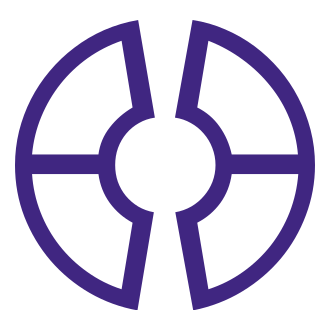
Much of this article was originally published in the May 2011 issue of WDWNT Magazine, and has been edited and updated with new information.
On May 20, 2011, the long wait ended. Years of rumors, discussions, leaks, hints, arguments, and anticipation came to a climax with a quick 15-minute, action-packed presentation signaling the official opening of Star Tours – The Adventures Continue. Now the world could finally, officially, see the results of years of planning and development by Walt Disney Imagineering, Industrial Light and Magic, and Lucasfilm.
The first rumors of updating Star Tours came about in the early 2000s, when the three prequel films were released. Many fans began asking if Lucas would turn his attention to the aging Star Tours attraction and work with Disney to update it based on the new movies. Fans received an answer in 2005 at Celebration III in Indianapolis, Indiana as George Lucas announced on day 3 of the event that Star Tours II was in development. (Of course, he also announced the Star Wars live action television show at the same time, so take that for what it’s worth.)
This announcement galvanized the imaginations of Disney fans and Star Wars fans alike as everyone wondered what the new Star Tours would bring.
For four years, people grabbed at every hint, leak, or even conjecture, in an attempt to learn what they could about the updates. Finally, in 2009, at the D23 Expo in Anaheim, California, then-Walt Disney Parks and Resorts Chairman Jay Rasulo announced that Star Tours – The Adventures Continue would be landing at Disneyland and Walt Disney World in 2011. As expected, this created a new frenzy of anticipation and speculation, which seemed to become even more intense in the days leading up to the official opening in Walt Disney World. After Cast Memberpreviews on May 13, and the first soft opening on May 14, social media exploded with reactions to the new Star Tours. All those years of wondering, watching, and waiting had come to an end.
The Star Tours update was easily one of the most anticipated updates ever planned for a Disney attraction. In fact, the frenzy at the time eclipsed that associated with many new attractions. And it’s not really that surprising, as not only do Star Wars and Disney have large, passionate fan bases, but the original Star Tours has entered the pantheon of classic Disney attractions and is certainly one of the most successful attractions ever built.
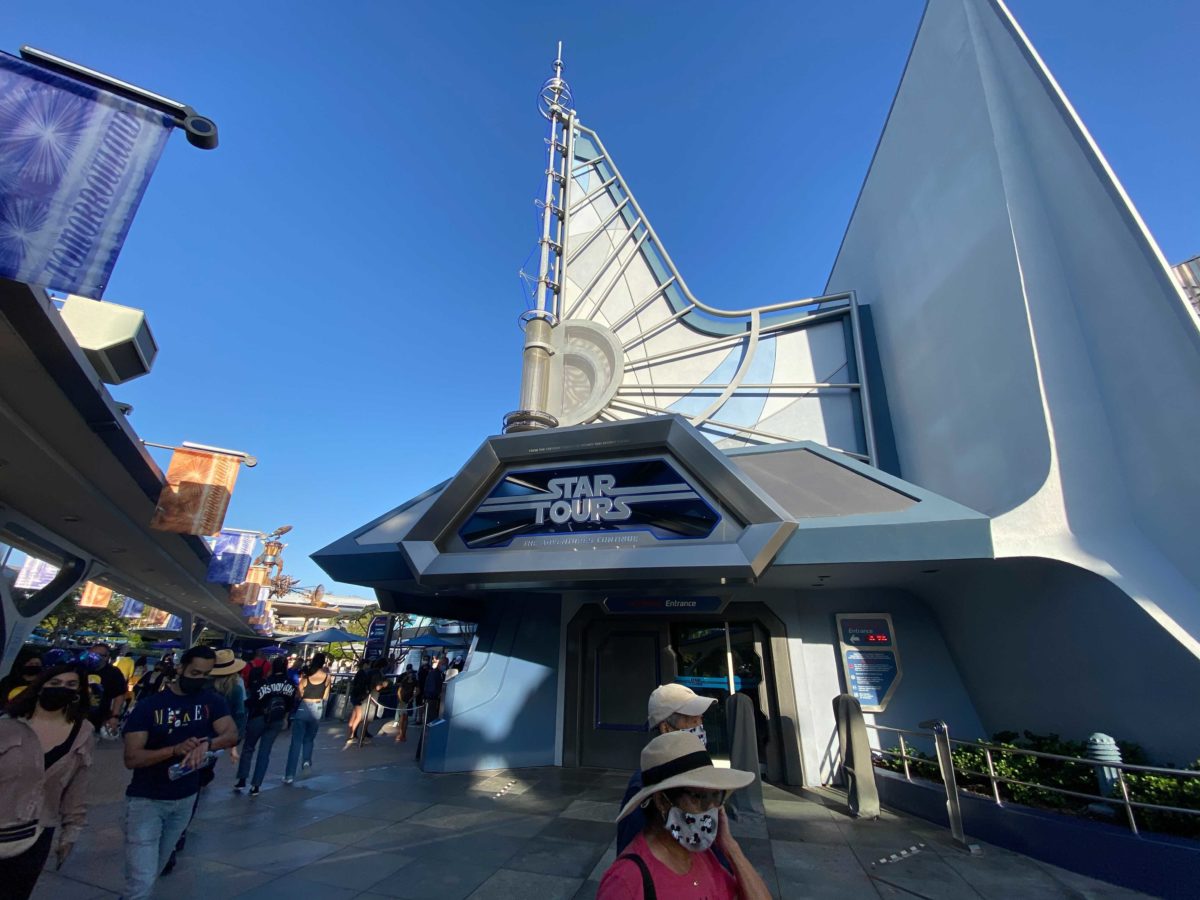
There are plenty of articles reviewing all the details of Star Tours – The Adventure Continues, so rather than add another one to that list, let’s look back at how the original attraction came to be. The creation story of Star Tours is really two stories that converge at a perfect moment in time— the evolution of the simulator ride system and the developing partnership between Lucasfilm and Disney.
A History of Motion Simulators
Motion simulation dates back to 1929 and steadily improved through the years, particularly as computer and control systems developed in the ’60s and ’70s, with the primary application of the technology was in flight training and flight simulation. These simulators tended to be very small and simplistic, such as the Link Trainer used extensively during World War II, or extremely expensive behemoths that only the armed forces or major airline carriers could afford. However, as microprocessor technology improved and became more common, the cost of true motion simulators was reduced to the point that by the mid-70’s, Disney began looking at the technology as a viable ride system for attractions.
The first proposed attraction to use the system was a Captain Nemo attraction that would be part of the Discovery Bay project planned for Disneyland and officially announced in 1976. However, initial planning on the attraction showed that the simulator technology was still not reliable enough for a theme park application. Of course, the entire project was shelved as Imagineering shifted their focus to building EPCOT Center and Tokyo Disneyland.
Motion simulation was revisited in 1979 as part of an attraction inspired by the film “The Black Hole”. The attraction budget was set at $50 million, but the poor performance of the movie caused Disney management to reconsider spending that amount of money.
By the early 80’s the simulator technology had advanced to the point of being a viable attraction system at the relatively low purchase price of $500,000 per military-grade simulator. Now the only question was how to use the motion simulators.
Meeting of the Titans
Historically, The Walt Disney Company has been hesitant to work with film properties outside their own library. However, with the lackluster performance of Disney films in the late 70’s, Imagineers found themselves searching for new heroes and stories to use as the foundation for new attractions within the parks. In the meantime, George Lucas was busy creating a universe and mythology unparalleled in film history, and changing American popular culture in the process.
By today’s thinking, a partnership between the creative powerhouses of Walt Disney Imagineering and Lucasfilm seems a natural collaboration after Disney outright bought Lucasfilm in 2012.. At the time though, it was anything but a sure thing. Disney was experiencing a period of instability with takeover attempts and short-term management. Many industry analysts were forecasting the end of the Disney brand and the sunset of the old way of storytelling. On the other side, Lucas represented the new wave of film-making and was in the process of completing the first “Star Wars” trilogy and building Lucasfilm, Industrial Light and Magic, and Skywalker Sound into industry powerhouses. If Disney was old-school, George Lucas definitely represented the new era of Hollywood.
In the midst of this turmoil, Imagineers recognized the need to bring more relevant characters and stories into the parks. Tony Baxter went to then president, Ron Miller, with the suggestion of working with George Lucas on a number of attractions for the parks. At first he was reluctant to work with someone outside the company, but Miller was eventually convinced, and a meeting was arranged between Marty Sklar, Tony Baxter, Ron Miller, and George Lucas. In this meeting, a number of concepts were created, but more importantly, it laid the groundwork for collaboration.
Shortly thereafter, Michael Eisner and Frank Wells were given control of the company and were eager to replace aging and outdated attractions with new properties designed to appeal to teens and older guests. Eisner had an existing relationship with Lucas from when Paramount Pictures was involved with Raiders of the Lost Ark, so he was comfortable working with Lucasfilm again. For Lucas, working with Disney was an easy decision, and stated on a number of occasions that if he couldn’t build a theme park himself, his first choice would be working Disney on attractions. In fact, Lucas had been in attendance on Disneyland’s opening day in 1955, and considered himself a Disney park fan.
And with that, the partnership between two titans of the entertainment industry was born. On the one side, the standard-bearer of family entertainment, and on the other, the creator of new epics told with amazing technology. Now the only question that remained—what would they create together?
Right Place, Right Time
The obvious place for the partners to start was with Lucas’s blockbuster space opera, “Star Wars”. The challenge to Imagineers was taking the trilogy’s detail-oriented story and rapid pacing and synthesizing that into a theme park attraction, which usually have a much more methodical pacing. As Tony Baxter noted, “In ‘Star Wars’, something seemed to be happening every few seconds.”
The initial concept consisted of a large enclosed roller coaster similar to Space Mountain which was to be called Jedi Training Academy. The coaster would have two paths- a “light” side, and a “dark” side that could be selected by the riders in each car. Each path would lead to various encounters with various elements of the Star Wars universe. However, this idea quickly became unwieldy due the very large building that would be required to house such an attraction.
Other ideas were tossed around, but fate intervened in 1984 when George Lucas was walking through Walt Disney Imagineering and came across storyboards of an attraction utilizing a motion simulator base. Lucas immediately saw the possibilities that such technology offered to a Star Wars attraction, and with that chance meeting, Star Tours was born. The story and the technology had come together to a single point in time. Now the only thing left to do was to design and build the attraction.
Early Planning
Imagineers quickly began building a cohesive story for the attraction. Lucas encouraged the designers to think beyond typical attractions and have one where everything goes wrong while focusing equally on both humor and thrills. Imagineers came up with a number of approaches to the attraction story, and Lucas selected the one he liked the best.
As originally conceived, the story would involve an intergalactic tour company named Star Tours that offered scenic tours of the universe in the comfort of Starspeeder 3000 spacecraft. Employees of Star Tours would include the recently retired C-3PO and R2-D2 acting as guides, while the role of the pilot droid went through a number of iterations. The first rendering of RX-24, nicknamed “Crazy Harry”, was more of a psychotic bus driver in the mode of a burned-out war veteran who unintentionally put his passengers in danger. In time, this persona was toned down to become the eager but inexperienced “Rex” of the final attraction.
The original script for the movie portion of the attraction had a running time of 20 minutes. With only four simulators planned for the attraction, this would have reduced guest capacity to fewer than 500 guests per hour. A great many cuts were made, at one point reducing the film running time to around 3 minutes 10 seconds. This was deemed too short of an experience, so the film was then lengthened to a final running time of 4 minutes 30 seconds, providing a much more acceptable guest capacity of around 1600 per hour with four simulators running.
The film and special effects were all created by Industrial Light and Magic at a cost of $6 million. It was shot on 70mm film at 30 frames per second to provide greater clarity and resolution to the film (most films used 35mm film at 24 fps). With the story set, all that was needed was a place to house the new attraction. As part of the Eisner and Wells’ overhaul of the parks, a number of attractions were identified as being outdated or irrelevant to modern audiences and thus candidates for replacement. Once such attraction was the Adventure Thru Inner Space. The New Tomorrowland attraction may have been modern and cutting-edge back in 1967, but by 1984, the Omnimover attraction was showing its age. Thus, Disney decided it was the perfect location to install the new Star Tours attraction.
Flight Delays
It was not all smooth sailing, however. Imagineers were working with a new ride technology that was both complicated and finicky, and the team responsible for programming the motion of the vehicles found it nearly impossible to synchronize the movement to the audio track of the film. This resulted in the custom development of a joystick-based programming system that allowed programmers to design movements in real-time with the film playing on the monitor.
Once that hurdle was passed, another larger one immediately appeared. During the programming phase, it was found that the roof of the building was too low for the range of movement required by the simulators. This required a major structural change to the building to raise the roof to the required level. In addition, the original budget and project plan for the attraction somehow did not include cosmetic work to the building, such as painting.
Finally, when George Lucas first heard the audio inside the simulators, he was not happy with the quality and requested that the audio system in all for simulators be replaced at a cost of an additional $100,000. The final budget swelled to $32 million, some $5 million over the original budget, and the opening was delayed by two months. By the beginning of 1987 though, all these problems had been overcome, and the attraction was ready for its moment in the spotlight.
“ST45, you are cleared for takeoff…”
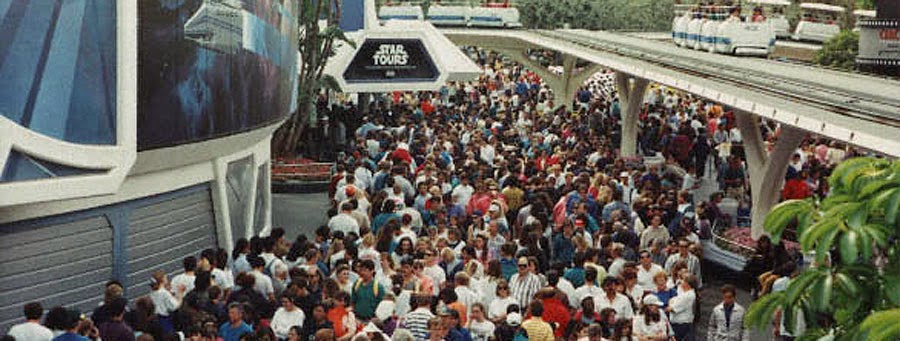
On January 9, 1987, Disneyland opened its gates as usual at 10AM. However, unlike most mornings, this morning saw a large throng of people, many dressed as Star Wars characters, race down Main Street U.S.A. and make the right turn towards Tomorrowland. Within minutes, a line of people stretched from the door of Star Tours all the way to Main Street. It was opening day for the attraction, and word had gotten out. As part of the opening celebration, the park would remain open for the next 60 hours, closing at 10pm on January 11.
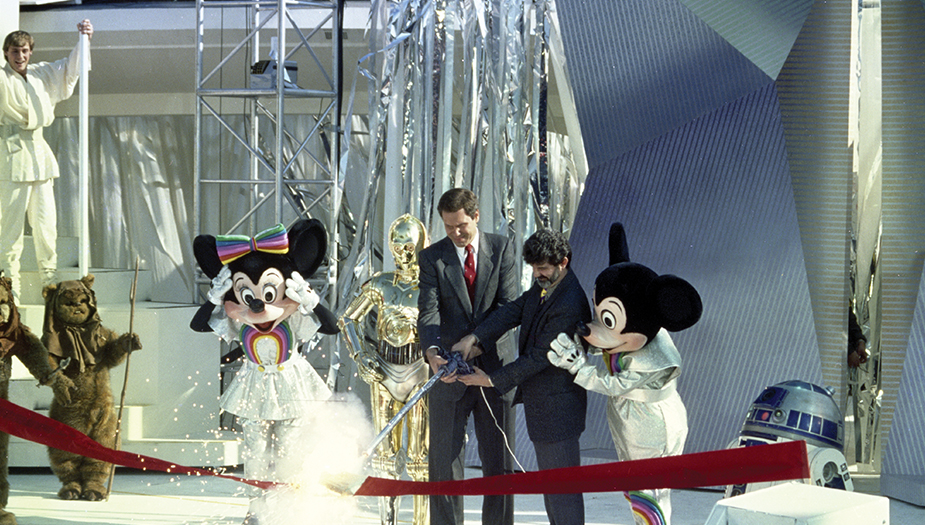
The official opening ceremony saw appearances by Luke, Leia, Han, Chewbacca, several Ewoks, Darth Vader, and a company of Stormtroopers. The Stormtroopers were quickly driven off by a few well-placed laser blasts from the heroes, with Michael Eisner and George Lucas took the stage to have a stiff, uncomfortable conversation with C-3PO and R2-D2. At this point in the ceremony, a rainbow space suit (it was the 1980’s, after all) clad Mickey and Minnie Mouse appeared to cut the ribbon with a pyrotechnic assist. With that, the attraction officially opened, and changed the Disney theme parks forever.
Guest response was overwhelmingly positive, and it was obvious that all the hard work by Walt Disney Imagineering, Lucasfilm, and ILM had paid off with an attraction that would be popular for years to come.
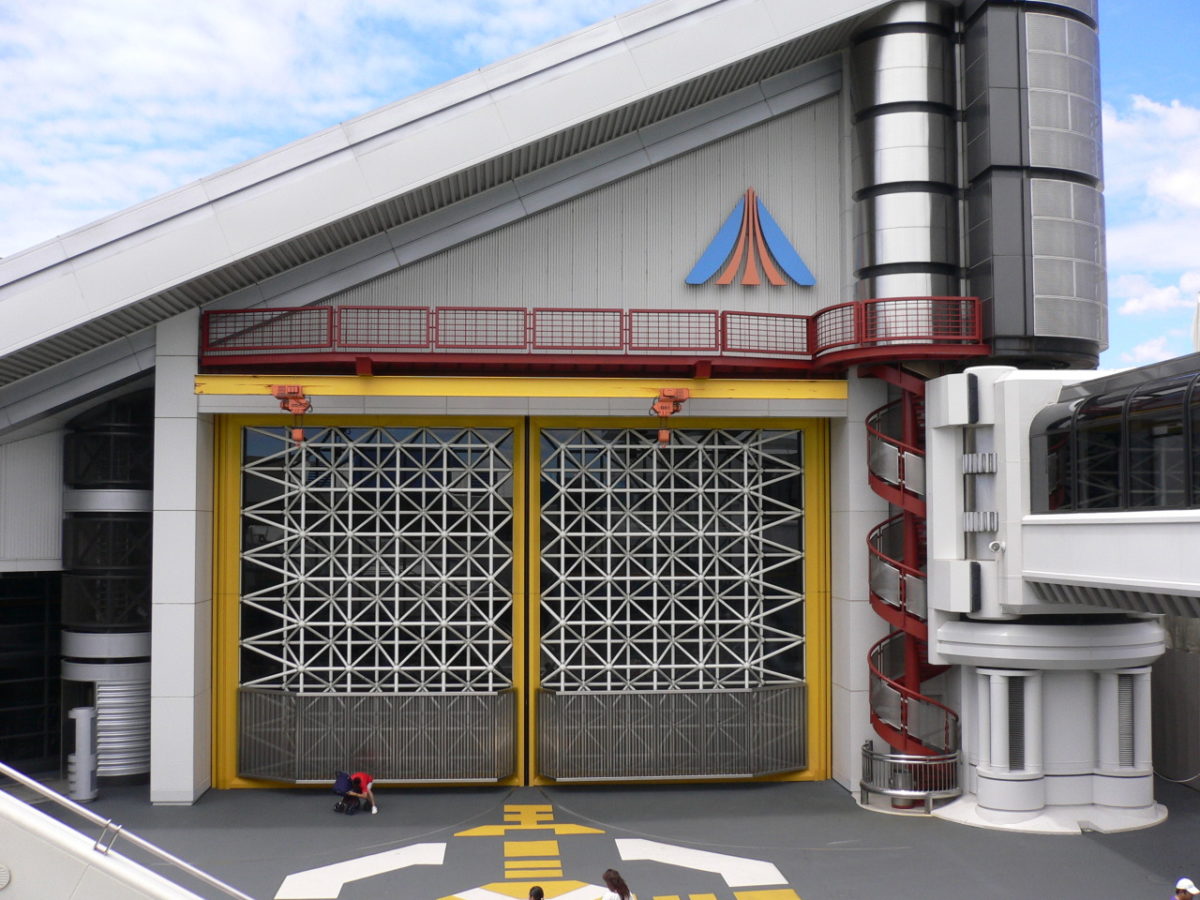
Guest reaction was so positive that plans were immediately made to install the attraction at Tokyo Disneyland and Walt Disney World. The “Star Wars” franchise is massively popular in Japan, so making Star Tours the second major addition to Tokyo Disneyland since its opening in 1983 was a match made in heaven. The structure is relatively similar to its California counterpart in layout, with six simulators instead of four and a large hangar room at the entrance flanked by a three-story window looking out on Tomorrowland. Star Tours opened July 12, 1989 in the Japan park.
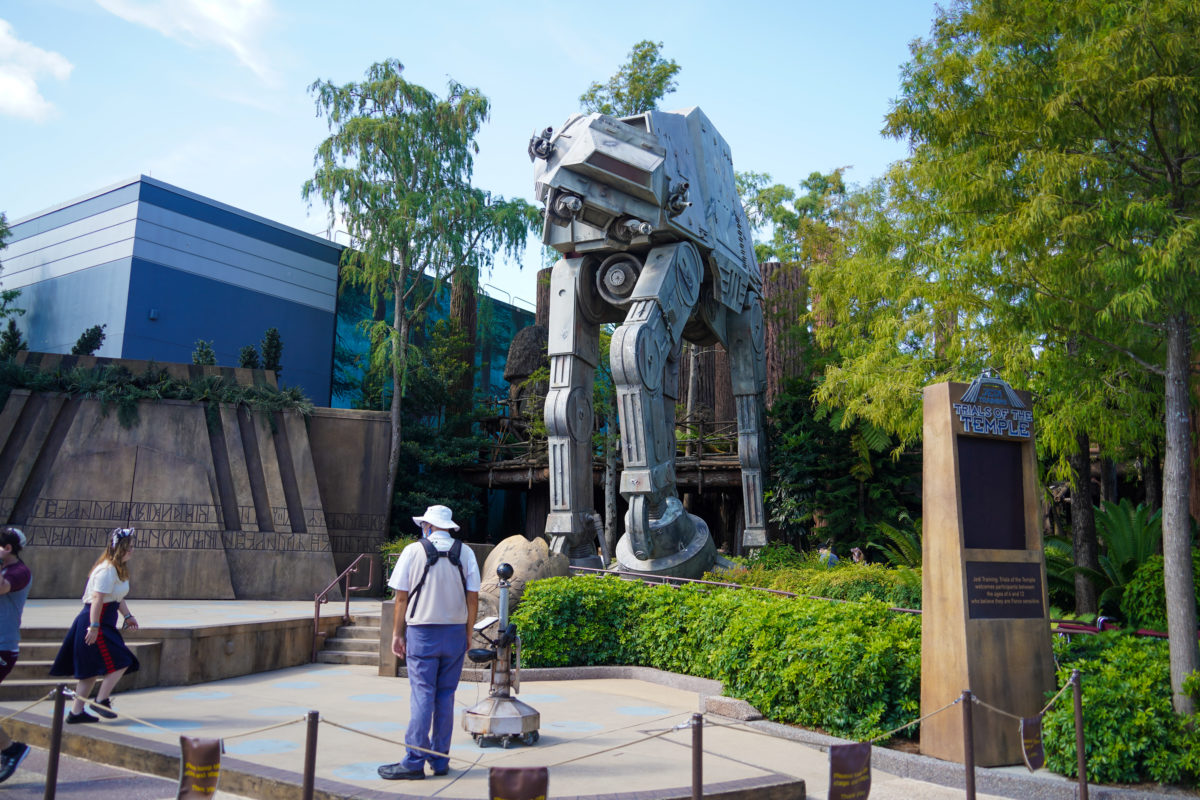
Disney also announced very quickly that the attraction would be coming to Walt Disney World in Florida. However, around this time, planning began for Walt Disney World’s third gate—Disney-MGM Studios. As the budget for the Studios continued to climb, Disney realized that Star Tours could find a more appropriate home in the Studios with the added benefit of being an existing ride, saving the development costs of a new attraction.
The Walt Disney World version would be virtually the same as the Disneyland version except for the exterior façade. The Studios façade allowed Imagineers to create a much more heavily themed building that fit in with the overall theme of the park, based on the forest moon of Endor from “Return of the Jedi”. Like the Tokyo version, the Walt Disney World version also features six simulators instead of four, and opened on December 15, 1989.
Star Tours’ final installation would be at Disneyland Paris, where it was an opening day attraction with the park on April 12, 1992. There were no fundamental differences between this version of the attraction and the others.
A New Universe
As a park attraction, Star Tours raised the bar for immersive guest experience and set a new standard for themed entertainment. From the moment guests entered the attraction to the moment they left the building, they became part of the Star Wars galaxy in a way no attraction had ever done prior, and very few have done since. The queue was filled with sights and sounds that made people forget they were standing in a line. The pre-show provide the perfect mix of humor and anticipation. The actual ride could be enjoyed by casual Star Wars fans, hard-core Star Wars fans (but probably not without a discussion of the canon and timeline), and the small percentage of people who had never heard of Star Wars. The quality of the attraction is demonstrated by its longevity (it ran for over 20 years without a major update), and popularity of Star Tours – The Adventures Continue which is still running on the same fundamental ride system as was developed back in 1985 (albeit with some major technical upgrades). The ride system developed on Star Tours went on to be used in other Disney attractions around the world, including Body Wars at EPCOT, StormRider at Tokyo DisneySea, and the Iron Man Experience at Hong Kong Disneyland, as well as other simulator attractions at theme parks worldwide.
Star Tours—The Adventures Continue has since made its way around the world, taking over the Tokyo version in 2013 for the park’s 30th Anniversary, and the Paris version in 2017. Scenes and storylines have since been added to every iteration worldwide themed to the Sequel Trilogy of “Star Wars” films released between 2015 and 2019, and even with the advent of Star Wars: Galaxy’s Edge in both Disneyland and Walt Disney World, the original attraction remains popular among guests.
Beyond just the attraction though, Star Tours also reflects the significant shift in thinking for Walt Disney Imagineering. They were finally breaking out of the “What would Walt do” mode that had become a handicap to new innovation, and now focusing more on creating stories for contemporary audiences. Star Tours showed that Disney parks could be more than just “boring” theme parks aimed as children, but could provide an inclusive experience for every age group. Yes, Star Tours brought us into the Star Wars universe, but more importantly, it brought us into the new universe of theme park attraction design and philosophy.
The post Looking Back on the History and Impact of the Original Star Tours 35 Years Later appeared first on WDW News Today.
